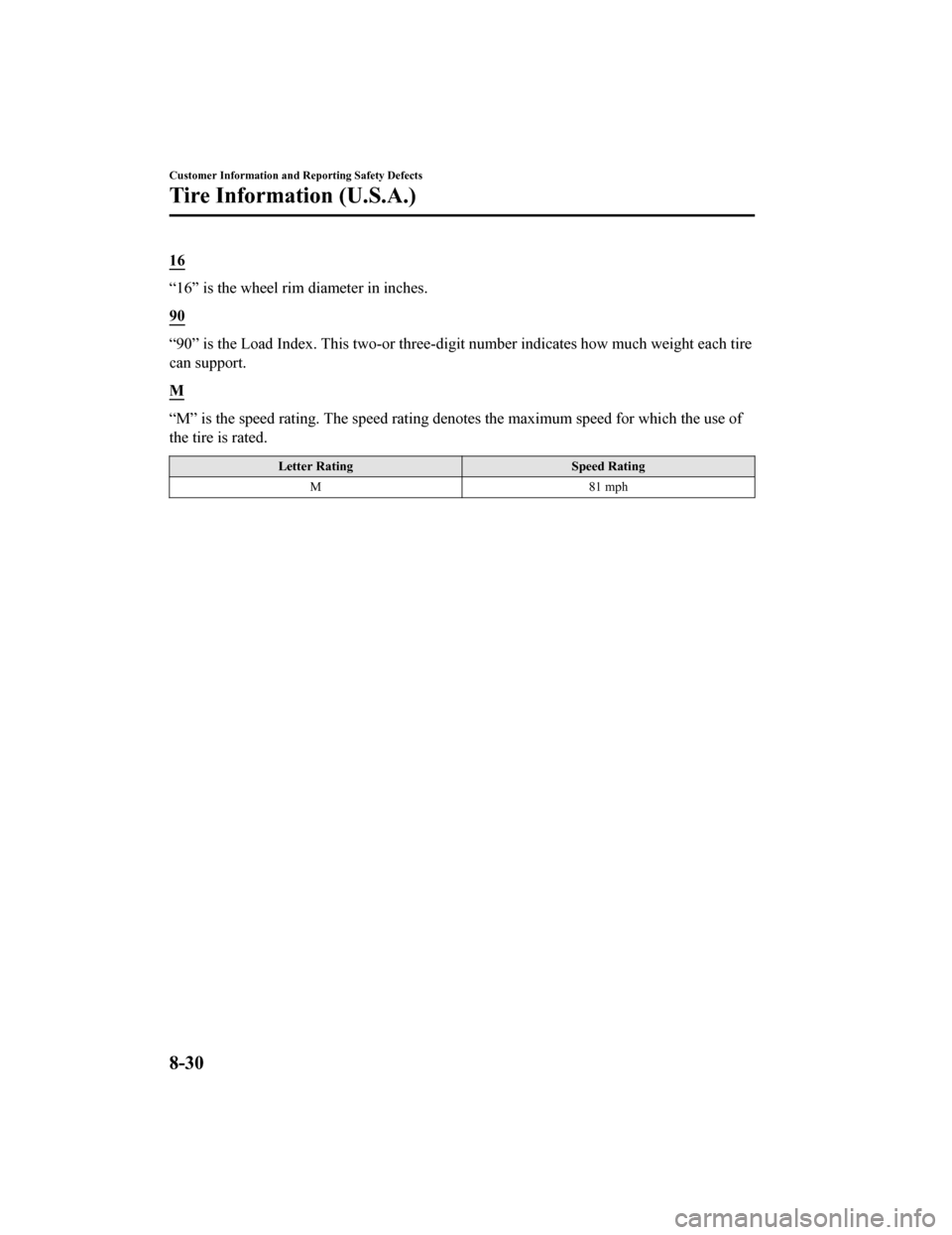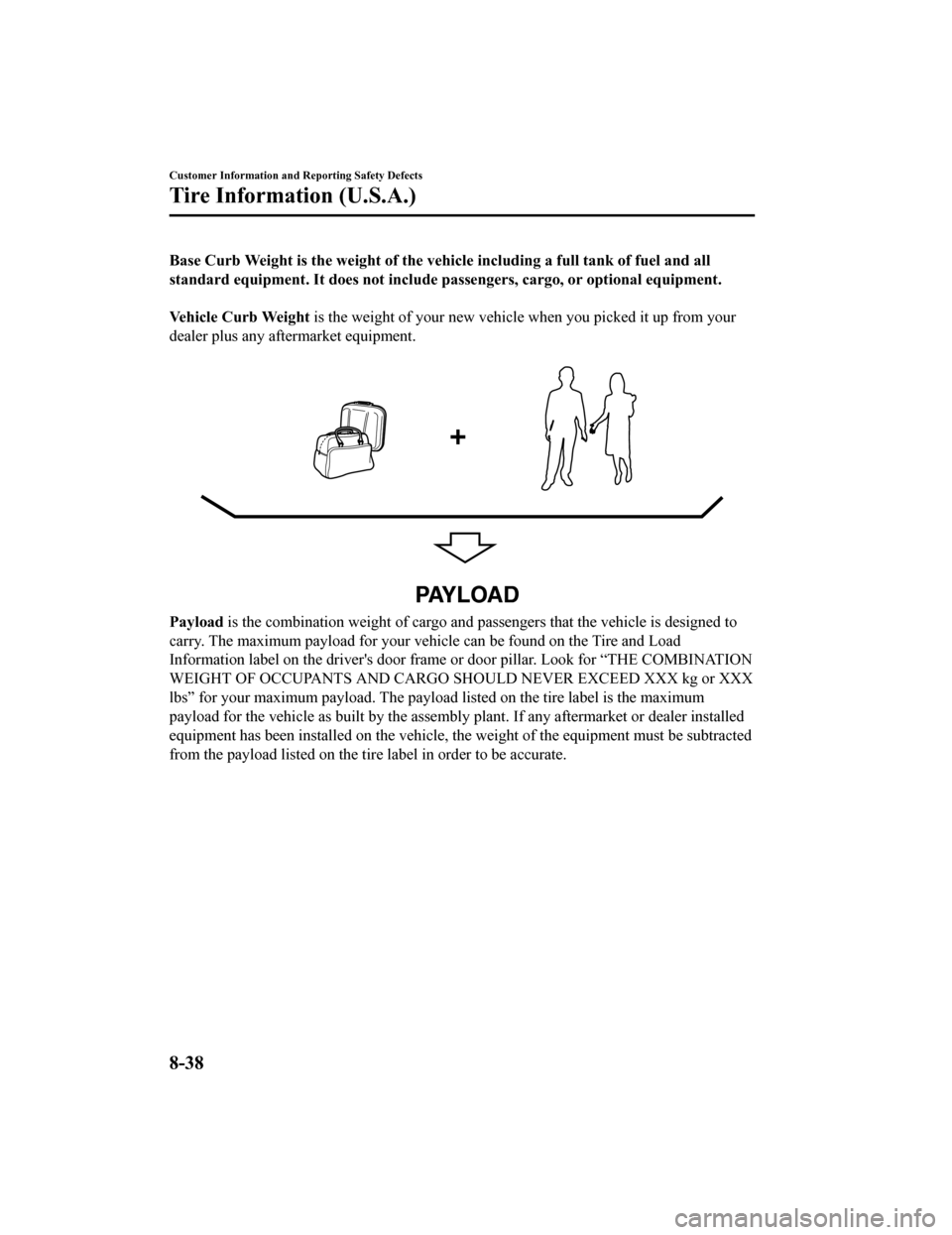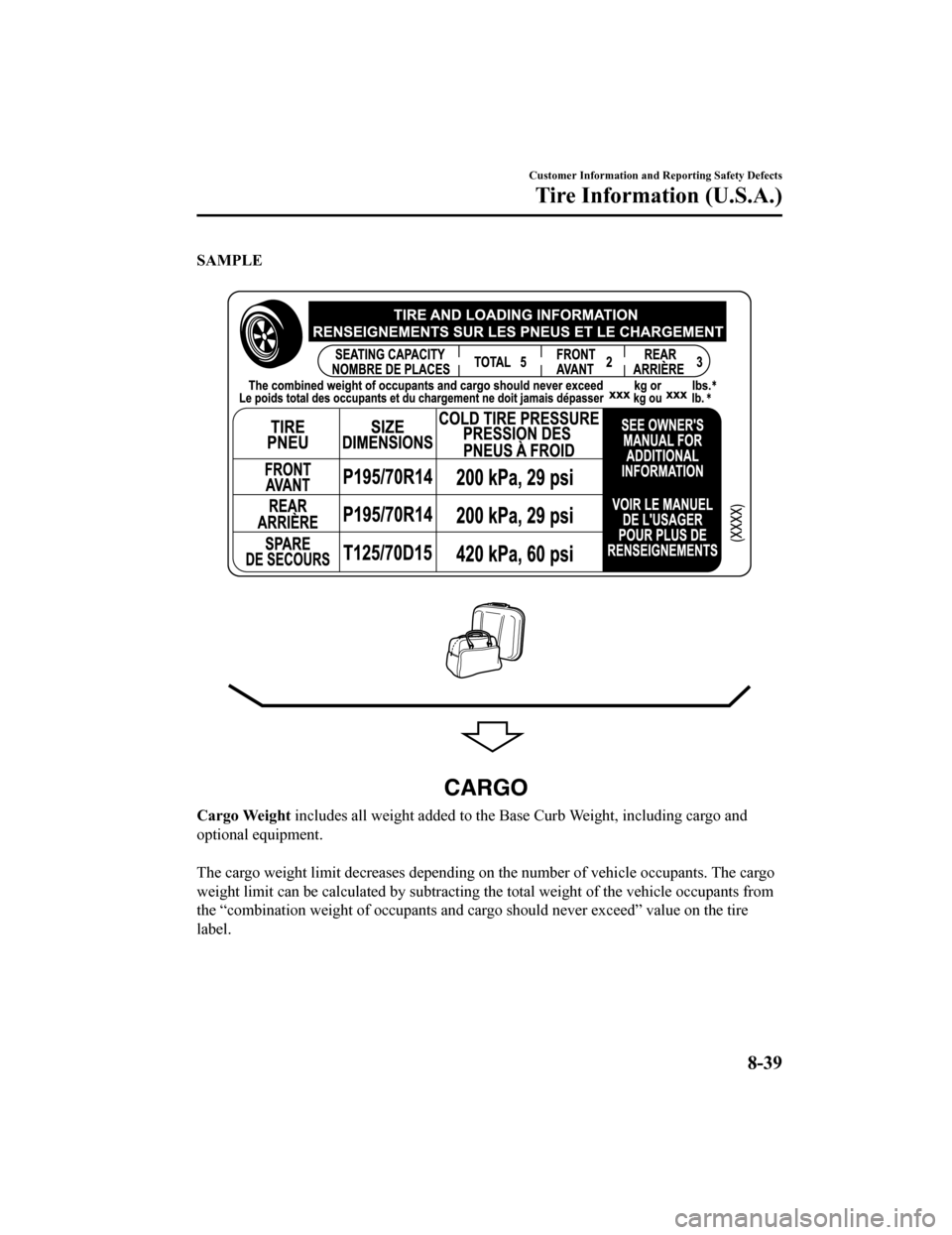weight MAZDA MODEL MX-5 2018 (in English) User Guide
[x] Cancel search | Manufacturer: MAZDA, Model Year: 2018, Model line: MODEL MX-5, Model: MAZDA MODEL MX-5 2018Pages: 576, PDF Size: 57.19 MB
Page 406 of 576

Tires
For reasons of proper performance, safety,
and better fuel economy, always maintain
recommended tire inflation pressures and
stay within the recommended load limits
and weight distribution.
WA R N I N G
Using Different Tire Types:
Driving your vehicle with different types of
tires is dangerous. It could cause poor
handling and poor braking; leading to loss
of control.
Except for the limited use of the temporary
spare tire, use only the same type tires
(radial, bias-belted, bias-type) on all four
wheels.
Using Wrong-Sized Tires:
Using any other tire size than what is
specified for the vehicle (page 9-8) is
dangerous. It could seriously affect ride,
handling, ground clearance, tire clearance,
and speedometer calibration. This could
cause you to have an accident. Use only
tires that are the correct size specified for
the vehicle.
▼ Tire Inflation Pressure
WA R N I N G
Always
inflate the tires to the correct
pressure:
Overinflation or
underinflation of tires is
dangerous. Adverse handling or
unexpected tire failure could result in a
serious accident.
Refer to Tires on page 9-8.
Use only a Mazda-genuine tire valve cap:
Use of a non-genuine part is dangerous as
the correct tire air pressure cannot be
maintained if the tire valve becomes
damaged. If the vehicle is driven under this
condition, the tire air pressure will decrease
which could result in a serious accident. Do
not use any part for the tire valve cap that
is not a Mazda-genuine part.
Inspect all tire pressures monthly when the
tires are cold. Maintain recommended
pressures for the best ride, handling, and
minimum tire wear.
Refer to the specification charts (page 9-
8).
NOTE
Always check tire pressure when tires
are cold.
Warm tires normally exceed
recommended pressures. Do not release
air from warm tires to adjust the
pressure.
Underinflation can cause reduced fuel
economy, uneven and accelerated tire
wear, and poor sealing of the tire bead,
which will deform the wheel and cause
separation of tire from rim.
Maintenance and Care
Owner Maintenance
6-36
MX-5_8GF7-EA-17J_Edition2 2017-10-31 14:07:27
Page 478 of 576

SignalWarning Action to be taken
Seat Belt Warning
Light Mexico
The seat belt warning light turns on if the
driver or passenger's seat is occupied and
the seat belt is not fastened with the ignition
switched ON.
If the driver or passenger's seat belt is un-
fastened (only when th
e passenger's seat is
occupied) and the vehicle is driven at a
speed faster than about 20 km/h (12 mph),
the warning light flash es. After a short time,
the warning light stops flashing, but re-
mains illuminated. If a seat belt remains un-
fastened, the warning light flashes again for
a given period of time.
NOTE
Placing heavy items on the passenger's
seat may cause the passenger's seat belt
warning function to operate depending on
the weight of the item.
To allow the passenger seat weight sensor
to function properly, do not place and sit
on an additional seat cushion on the pas-
senger's seat. The sensor may not function
properly because the ad ditional seat cush-
ion could cause sensor interference.
If a small child is seated on the passeng-
er's seat, the warnin g light may not oper-
ate. Fasten the seat belts.
Door-Ajar/Trunk
lid-Ajar Warning Indi- cation/Warning Light The light turns on if any door/trunk lid is
not closed securely.
Close the door/trunk lid securely.
Low Fuel Warning
Light The light turns on when
the remaining fuel
is about 9.0 L (2.3 US gal, 1.9 Imp gal).
NOTE
The light illumination timing may vary be-
cause fuel inside the fuel tank moves
around according to the driving conditions
and the vehicle posture. Add fuel.
Check Fuel Cap Warn-
ing Light If the check fuel cap warning light illumi-
nates while driving, the fuel-filler cap may
not be installed properly.
Stop the engine and reinstall the fuel-filler
cap.
Refer to Refueling on page 3-26
If Trouble Arises
Warning/Indicator Lights and Warning Sounds
7-42
MX-5_8GF7-EA-17J_Edition2
2017-10-31 14:07:27
Page 486 of 576

NOTE
To allow the passenger occupant
classification sensor to function
properly, do not place and sit on an
additional seat cushion on the
passenger's seat. The sensor may not
function properly because the additional
seat cushion could cause sensor
interference.
If a small child is seated on the
passenger's seat, the warning beep may
not operate.
Mexico
If the vehicle speed exceeds about 20
km/h (12 mph) with the driver or
passenger's seat belt unfastened, a warning
beep sounds continuously. If the seat belt
remains unfastened, the beep sound stops
once and then continues for about 90
seconds. The beep stops after the driver or
passenger's seat belt is fastened.
Until a seat belt is fastened or a given
period of time has elapsed, the beep sound
will not stop even if the vehicle speed falls
below 20 km/h (12 mph).
NOTE
Placing heavy items on the passenger's
seat may cause the passenger's seat belt
warning function to operate depending
on the weight of the item.
To allow the passenger seat weight
sensor to function properly, do not place
and sit on an additional seat cushion on
the passenger's seat. The sensor may not
function properly because the additional
seat cushion could cause sensor
interference.
If a small child is seated on the
passenger's seat, the warning beep may
not operate.
▼ Retractable Hardtop Warning Beep*
When operating the retractable hardtop
switch, the warning beep is activated when
the retractable hardtop operation begins
and when it is completed.
If there is a problem with the retractable
hardtop, the warning beep is activated
continuously while operating the switch. If
the warning beep is activated continuously
while operating the switch, have the
vehicle inspected at an Authorized Mazda
Dealer.
▼Ignition Not Switched Off (STOP)
Warning Beep
If the driver's door i
s opened with the
ignition switched to ACC, a beep will be
heard continuously in the cabin to notify
the driver that the ignition has not been
switched OFF (STOP). Under this
condition, the keyless entry system will
not operate, the vehicle cannot be locked,
and the battery volta ge will be depleted.
▼Key Removed from Vehicle Warning
Beep
Vehicles with advance
d keyless function
If the key is taken out of the vehicle while
the ignition is not switched OFF and all
the doors are closed, the beep which
sounds outside of the vehicle will be heard
6 times, the beep which sounds inside the
vehicle will be heard 6 times, and the
KEY warning light (red) in the instrument
cluster flashes continuously to notify the
driver that the ig nition has not been
switched OFF.
If Trouble Arises
Warning/Indicator Lights and Warning Sounds
7-50*Some models.
MX-5_8GF7-EA-17J_Edition2 2017-10-31 14:07:27
Page 528 of 576

P215/65R15 95H is an example of a tire size and load index rating. Here is an explanation
of the various components of tha t tire size and load index rating. Note that the tire size and
load index rating may be different from the example.
P
Indicates a tire that may be ins talled on cars, SUVs, minivans and light trucks as designated
by the Tire and Rim Association (T&RA).
NOTE
If your tire size does not begin with a letter this may mean it is designated by either ETRTO
(European Tire and Rim Technical Organization) or JATMA (Japan Tire Manufacturing
Association).
215
“215” is the nominal width of the tire in millimeters. This thr ee-digit number gives the
width in millimeters of the tire from sidewall edge to sidewall edge. In general, the larger
the number, the wider the tire.
65
“65” is the aspect ratio. This two-digit number indicates the t ire's ratio of height to width.
R
“R” is the tire construction symbol. R indicates “Radial ply co nstruction”.
15
“15” is the wheel rim diameter in inches.
95
“95” is the Load Index. This two-or three-digit number indicate s how much weight each tire
can support.
H
“H” is the speed rating. The speed rating denotes the maximum s peed for which the use of
the tire is rated.
Letter Rating Speed Rating
Q9 9 m ph
R1 06 m ph
S 112 mph
T 118 mph
U1 24 m ph
H1 30 m ph
Customer Information and Reporting Safety Defects
Tire Information (U.S.A.)
8-26
MX-5_8GF7-EA-17J_Edition2 2017-10-31 14:07:27
Page 529 of 576

Letter RatingSpeed Rating
V 149 mph
W 168
* mph
Y 186
* mph
* For tires with a maximum speed capability over 149 mph, tire manufacturers sometimes use the letters ZR. For
tires with a maximum speed cap ability over 186 mph, tire manufa cturers always use the letters ZR.
MS or M/S: Mud and Snow
AT: All Terrain.
AS: All Season. The “M
S” or “M/S” indicates that the tire has some functional use in mud
and snow.
U.S. DOT Tire Identifi cation Number (TIN)
This begins with the letters “DOT” which indicates the tire mee ts all federal standards. The
next two numbers or letters are the plant code where it was man ufactured, and the last four
numbers represent the week and year the tire was manufactured. For example, the numbers
457 means the 45st week of 1997. After 2000 the numbers go to f our digits. For example,
the number 2102 means the 21th week of 2002. The other numbers are marketing codes
used at the manufacturer's discretion. This information is used to contact consumers if a tire
defect requires a recall.
Tire Ply Composition and Materials Used
The number of plies indicates the number of layers of rubber-co ated fabric in the tire. In
general, the greater the number of plies, the more weight a tir e can support. Tire
manufacturers also must indicate the tire materials, which incl ude steel, nylon, polyester,
and other.
Maximum Load Rating
This number indicates the maximum load in kilograms and pounds that can be carried by the
tire.
Maximum Permissible Inflation Pressure
This number is the greatest amoun t of air pressure that should ever be put in the tire under
normal driving conditions.
Tread Wear, Traction and Temperature Grades
Tr e a d w e a r : The tread wear grade is a comparative rating based on the wear rate of the tire
when tested under controlled con ditions on a specified government test course. For
example, a tire graded 150 would wear one and one-half (1 1/2) times as well on the
government course as a tire graded 100.
Customer Information and Reporting Safety Defects
Tire Information (U.S.A.)
8-27
MX-5_8GF7-EA-17J_Edition2 2017-10-31 14:07:27
Page 532 of 576

16
“16” is the wheel rim diameter in inches.
90
“90” is the Load Index. This two-or three-digit number indicate s how much weight each tire
can support.
M
“M” is the speed rating. The speed rating denotes the maximum s peed for which the use of
the tire is rated.
Letter Rating Speed Rating
M8 1 m ph
Customer Information and Reporting Safety Defects
Tire Information (U.S.A.)
8-30
MX-5_8GF7-EA-17J_Edition2 2017-10-31 14:07:27
Page 535 of 576

▼Glossary of Terms
Tire Placard:
A label indicating the OE tire sizes, recommended inflation pressure, and the
maximum weight the vehicle can carry.
Tire Identification Number (TIN): A number on the sidewall of each tire providing
information about the tire brand and manufacturing plant, tire size, and date of manufacture.
Inflation Pressure: A measure of the amount of air in a tire.
kPa: Kilopascal, the metric u nit for air pressure.
psi: Pounds per square inch, the English unit for air pressure.
B-pillar: The structural member at the side of the vehicle behind the front door.
Original Equipment (OE): Describes components originally equipped on the vehicle.
Vehicle Load Limit: The maximum value of the combination weight of occupants and
cargo.
Bead Area of the Tire: Area of the tire next to the rim.
Sidewall Area of the Tire: Area between the bead area and the tread.
Tread Area of the Tire: Area on the perimeter of the t ire that contacts the road when it's
mounted on the vehicle.
Seating capacity means the total allowable numbe r of vehicle occupants. Seating capacity
is described on the tire label.
Production options weight is the combination weight of installed regular production
options weighing over 2.3 kilograms in excess of the standard i tems which they replace, and
not previously considered in the curb weight or accessory weigh t, including heavy duty
brakes, ride levelers, roof rack, heavy duty battery, and speci al trim.
Rim is the metal support (wheel) for a tire or a tire and tube ass embly upon which the tire
beads are seated.
Customer Information and Reporting Safety Defects
Tire Information (U.S.A.)
8-33
MX-5_8GF7-EA-17J_Edition2 2017-10-31 14:07:27
Page 539 of 576

Vehicle Loading
WA R N I N G
Do not tow a trailer with this vehicle:
Towing a trailer with this vehicle is dangerous because it has not been designed to tow a
trailer and doing so will affect the drive sy stem which could result in vehicle damage.
This section will guide you in the proper loading of your vehic le, to keep your loaded
vehicle weight within its desig n rating capability. Properly loading your vehicle will provide
maximum return of vehicle design performance. Before loading yo ur vehicle, familiarize
yourself with the following term s for determining your vehicle's weight ratings, from the
vehicle's Safety Certification La bel and Tire and Load Information Label:
WA R N I N G
Overloaded Vehicle:
Overloading a vehicle is dangerous. The results of overloading can have serious consequences
in terms of passenger safety. Too much weight on a vehicle's suspension system can cause
spring or shock absorber failure, brake failure , handling or steering problems, irregular tire
wear, tire failure or other damage.
Overloading makes a vehicle harder to drive and control. It also increases the distance
required for stopping. In cases of serious overl oading, brakes can fail completely, particularly
on steep grades. The load a tire will carry safely is a combination of the size of the tire, its load
range, and corresponding inflation pressure.
Never overload the vehicle and always observe th e vehicle's weight ratings from the vehicle's
Safety Certification and Tire and Load Information labels.
Customer Information and Reporting Safety Defects
Tire Information (U.S.A.)
8-37
MX-5_8GF7-EA-17J_Edition2 2017-10-31 14:07:27
Page 540 of 576

Base Curb Weight is the weight of the vehicle including a full tank of fuel and all
standard equipment. It does not i nclude passengers, cargo, or optional equipment.
Vehicle Curb Weight is the weight of your new vehicle when you picked it up from y our
dealer plus any aftermarket equipment.
PAYLOAD
Payload is the combination weight of cargo and passengers that the veh icle is designed to
carry. The maximum payload for your vehicle can be found on the Tire and Load
Information label on the driver's door frame or door pillar. Lo ok for “THE COMBINATION
WEIGHT OF OCCUPANTS AND CARGO SHOULD NEVER EXCEED XXX kg or XXX
lbs” for your maximum payload. The payload listed on the tire l abel is the maximum
payload for the vehicle as built by the assembly plant. If any aftermarket or dealer installed
equipment has been installed on the vehicle, the weight of the equipment must be subtracted
from the payload listed on the t ire label in order to be accurate.
Customer Information and Reporting Safety Defects
Tire Information (U.S.A.)
8-38
MX-5_8GF7-EA-17J_Edition2 2017-10-31 14:07:27
Page 541 of 576

SAMPLE
CARGO
Cargo Weight includes all weight added to th e Base Curb Weight, including c argo and
optional equipment.
The cargo weight limit decreases depending on the number of veh icle occupants. The cargo
weight limit can be calculated by subtracting the total weight of the vehicle occupants from
the “combination weight of occupants and cargo should never exc eed” value on the tire
label.
Customer Information and Reporting Safety Defects
Tire Information (U.S.A.)
8-39
MX-5_8GF7-EA-17J_Edition2 2017-10-31 14:07:27